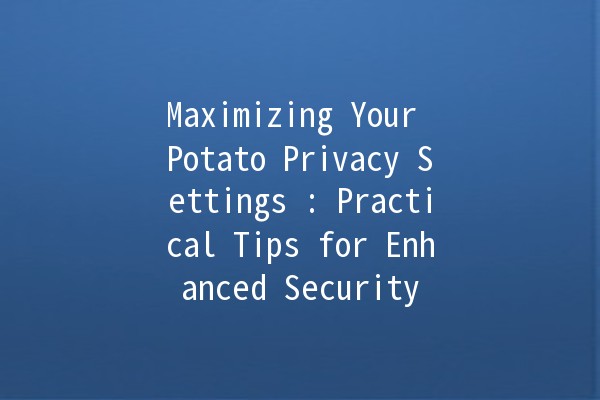In today's digital age, privacy is more important than ever, and applications like Potato provide specific settings to enhance user privacy. Understanding and optimizing your Potato privacy settings can lead to a more secure and enjoyable experience. Below, we delve into the key aspects of configuring your Potato privacy settings, offering practical advice and actionable tips to boost your overall security.
Understanding Potato Privacy Settings
Before diving into practical tips, let’s first understand what Potato is and what privacy settings it offers. Potato is a versatile application that allows users to connect and share information while maintaining a degree of privacy. However, with increased connectivity comes the need for more stringent privacy measures.
Setting your privacy options effectively helps to protect your personal information from unauthorized access and misuse. By adjusting these settings, you gain control over who can see your data, interact with you, and potentially collect information about you.
Tip 1: Customize Your Profile Privacy 🛡️
Explanation

The first step to enhancing your privacy on Potato is to customize your profile privacy settings. Often, applications default user profiles to a public status, meaning anyone can see your information. By configuring your profile settings, you minimize exposure to unwanted attention.
Implementation
Example
Imagine you're sharing a group project on Potato. If your profile is set to public, anyone can view your work, potentially leading to issues of data theft or uncredited use. By setting your profile to “Friends,” only those you trust can see your contributions, preserving both your work and your privacy.
Tip 2: Manage Your Friend List 👥
Explanation
In social applications like Potato, your interactions with others can impact your privacy significantly. Managing whom you connect with and how you interact with them is crucial in protecting your personal data.
Implementation
Example
Think about a scenario where you add acquaintances or people from work to your Potato friend list. If you do not manage your list carefully, they may gain access to personal information you would prefer to keep private. By regularly auditing your friend list and utilizing restrictions, you can ensure that only trusted individuals see your private information.
Tip 3: Control Location Sharing 📍
Explanation
One potentially risky feature of many applications is location sharing. Users often unknowingly disclose their whereabouts, which can pose security concerns. Disabling or limiting location sharing can significantly enhance your privacy.
Implementation
Example
If you regularly attend local events and share your location on Potato, you might inadvertently inform others about your movements. This could be problematic, especially if someone outside your trusted circle can track your habits. By controlling who sees your location and when, you maintain better privacy and security.
Tip 4: Regularly Update Your Privacy Settings 🔄
Explanation
Privacy settings are not set in stone. Over time, updates to Potato and changes in your social dynamic may warrant revisiting and updating your privacy preferences.
Implementation
Example
Let’s say Potato introduces a new feature that allows data analysis for ad personalization. This might default your settings to share more personal information than you intended. If you fail to revisit your settings, you could end up sharing information that impacts your digital footprint negatively.
Tip 5: Use TwoFactor Authentication (2FA) 🔐
Explanation
Twofactor authentication adds an extra layer of security to your Potato account, making it more challenging for unauthorized users to access your account.
Implementation
Example
If someone attempts to log into your Potato account from an unrecognized device, they will need both your password and a code sent to your mobile device. This added step can prevent unauthorized access, safeguarding your private information.
Frequently Encountered Questions
Potato’s default settings often allow maximum visibility, meaning your profile may be public and easily searchable. Adjusting these settings is crucial for your privacy.
Yes, Potato allows you to select the audience for each post, enabling you to share information with selected friends or groups instead of everyone.
No; if you properly disable location services, Potato should not track your whereabouts. Always review app permissions to ensure your privacy preferences are upheld.
If you believe your privacy is compromised, use the reporting features in the Potato app to notify the administrators of the issue.
Potato typically allows you to reset your settings to default or reconfigure your settings manually; however, it’s wise to keep a personal record of desired settings.
Using a VPN can enhance your overall privacy and security while using Potato, but it's typically an additional layer of security rather than a necessity if your settings are configured correctly.
By taking proactive steps to manage your Potato privacy settings, you can significantly enhance your online security. Implementing these practical tips allows you to enjoy your Potato experience while retaining the control you deserve over your personal information.